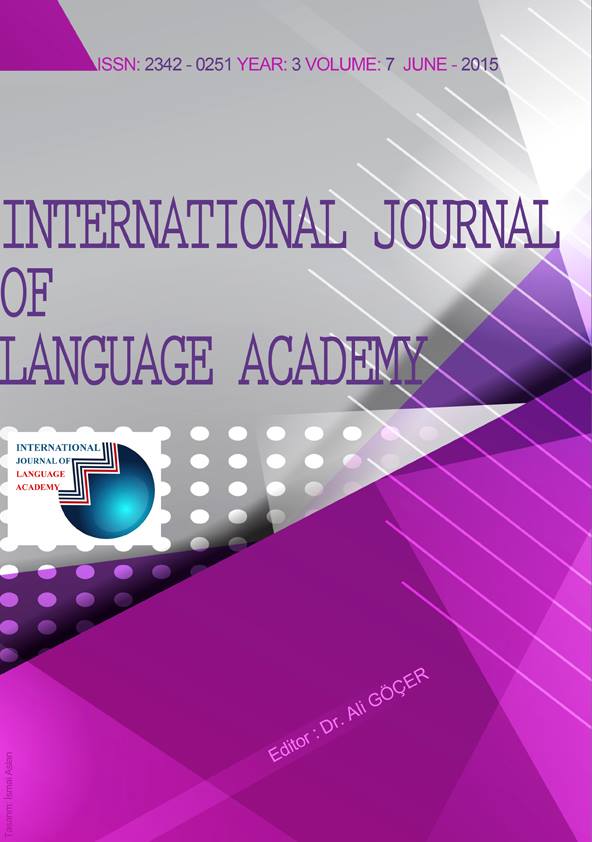Author :
Abstract
Türkiye’de İngilizce dersleri 2. Sınıftan itibaren zorunlu ders kapsamında okutulmakta ve her yıl daha fazla öğrenci kreşler, anaokulları ve özel kurslarda İngilizceyi daha erken yaşta öğrenmeye başlamaktadırlar. Bu betimsel çalışma da yabancı dil olarak İngilizce öğrenmekte olan çocukların İngilizce ve diğer yabancı dilleri öğrenmelerindeki amaçları araştırmaktadır. Antalya’da özel bir kursta İngilizce öğrenmekte olan 11-12 yaşlarındaki toplam 20 öğrenciyle yüz yüze ve yapılandırılmış sorularla yapılan görüşmelerle veriler toplanmıştır. Kayıtlar daha sonar Türkçeye aktarılmış ve İngilizceye çevrilmiştir. Tercüme edilen kayıtlar daha sonra içerik analizine tabi tutulmuştur. Araştırmanın sonuçlarına göre çocuklar İngilizceyi daha çok dışsal motivasyonla öğrenmek istemektedir. Öğrenciler İngilizcenin dışında en çok ayrıca İspanyolcayı öğrenmek istemekte ve onu da Fransızca ve Rusça izlemektedir. Öğrencilerin öğrendikleri betimlerken ve de o dilleri öğrenme amaçlarını ya da gerekçelerini belirtirken duygusal bir dil kullandıkları görülmüştür. Çalışmanın sonuçları da her ne kadar küçük bir grup öğrenciyle çalışılmış olsa da, konusu açısından alanda ve ülkemiz bağlamındaki ilk çalışmalardan olması açısından önemlidir.
Keywords
Abstract
English has become a compulsory lesson starting at the second grade in Turkey while younger learners are growingly introduced to it at earlier ages through various pre-schools, day-care programs and private courses. This descriptive study focuses on young learners’ self-reported reasons for learning English and other foreign languages. Twenty children (11-12 year-olds) who have been studying for over two years at a private language school in Antalya participated in the study through structured face-to-face interview questions. After completing the recordings, the data were transcribed and translated into English. Content analysis was used to analyze the data. Results of the study have shown that students want to learn Spanish as a foreign language after English. In addition to these languages, French and Russian were counted as the languages students wanted to learn as foreign languages. This study also found that the participants were mostly extrinsically motivated as learners. It is also noteworthy that young learners who participated in the study used an emotional language while describing the language(s) they were learning or while mentioning their reasons for studying these languages. Although the study is limited to a small group of young learners, it is important in that it is one of the first studies in the field and within the context of our country.
Keywords
- Arikan, A., & Ulaş-Taraf, H. (2010). Contextualizing young learners’ English lessons with cartoons: Focus on grammar and vocabulary. Procedia: Social and Behavioral Sciences, 2(2), 5212- 5215.
- Broussard, S. C., & Garrison, M. E. (2004).The relationship between classroom motivation and academic achievement in elementary-school-aged children. Family & Consumer Sciences Research Journal, 33(2), 106-120.
- Day, E. M. (2002). Identity and the young English language learner. New York: Multilingual Matters.
- Djigunović, J. M. (2012). Attitudes and motivation in early foreign language learning. CEPS Journal, 2(3), 55-74.
- Dörnyei, Z. (2001). Teaching and researching motivation. Longman: Pearson Education Limited.
- Edelenbos, P., Johnstone, R., & Kubanek, A. (2006). The main pedagogical principles underlying the teaching of languages to very young learners: Languages for the children of Europe: Published research, good practice and main principles. European Commission Report. Retrieved on May 18, 2015 from http://ec.europa.eu/languages/policy/language-policy/documents/young_en.pdf
- Gardner, R. C. (1985). Social psychology and second language learning. Baltimore, MA: Edward Arnold.
- Gardner, R. C., & Lambert, W. E. (1972). Attitudes and motivation in second language learning. Rowley, MA: Newbury House.
- Gardner, R. C., & MacIntyre, P. D. (1993). A student’s contributions to second language learning. Part II: Affective variables. Language Teaching, 26, 1-11.
- Kennedy, T. J., Nelson, J. K., Odell, M. R., & Austin, L. K. (2000). The FLES attitudinal inventory. Foreign Language Annals, 33(3), 278-289.
- Lightbown, P. M., & Spada, N. (2007). How languages are learned. Oxford: Oxford University Press.
- Nikolov, M. (1999). ‘Why do you learn English?’‘ Because the teacher is short: A study of Hungarian children’s foreign language learning motivation. Language Teaching Research, 3(1), 33-56.
- Shin, J. K. (2007). Ten helpful ideas for teaching English to young learners. English Teaching Forum, 44(2), 2-7.
- Slavin, R. E. (2003). Educational psychology: Theory into practice (7th ed.). Boston: Allyn & Bacon.
- Sung, K. (2013). L2 motivation in foreign language learning. Journal of Language and Linguistic Studies, 9(2), 19-30.
- Tremblay, P. F., & Gardner, R. C. (1995). Expanding the motivation construct in language learning. The Modern Language Journal, 79, 505-518.
- Weedon, C. (1998). Feminism and the principles of poststructuralism. Cultural theory and popular culture: A reader. Athens: University of Georgia Press.
- Yolageldili, G., & Arikan, A. (2011). Effectiveness of using games in teaching grammar to young learners. Elementary Education Online, 10(1), 219-229.
- Yule, G. (2006). The study of language. New York, NY: Cambridge University Press.
